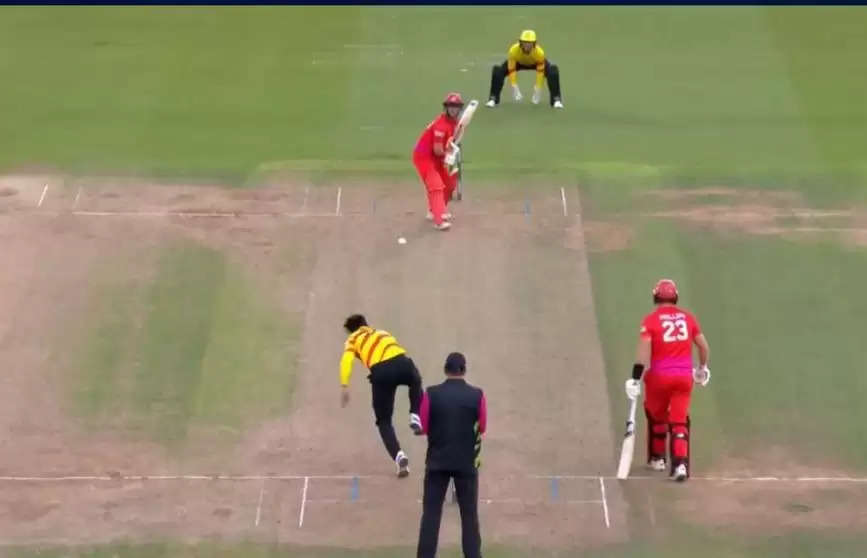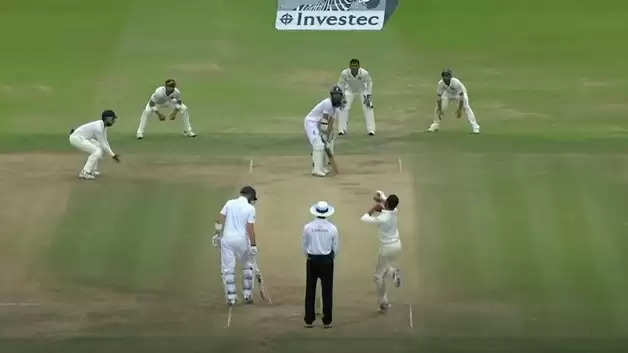Why was the Wicketkeeper standing back to Rashid Khan in The Hundred Men’s encounter?

Match 20th of the inaugural men’s The Hundred tournament between Trent Rockets and Welsh Fire in Cardiff this Friday (August 6) witnessed a rare sight on a cricket field. Rockets wicketkeeper Tom Moores was seen standing back to wrist-spinner Rashid Khan as he would in normal circumstances to any of his team’s fast bowler.
Much to the bewilderment of everyone watching, Moores, the son of ex England coach Peter Moores, didn’t stand up to the stumps as wicketkeepers usually do for spinners when Rashid ran up to bowl the first ball of his spell.
The delivery from Rashid was flicked across for a couple of runs by Welsh Fire batsman Ben Duckett but what raised eyebrows was the wicketkeeper’s standing position, especially as he returned to take the traditional spot off Rashid’s very next ball.

Also Read: How To Play Rashid Khan?

The wicketkeeper standing back to Rashid Khan in The Hundred.
With no public explanations yet from either Rashid Khan or Moores, cricket fans and experts are left confused why the gloveman stood so far back for a spinner?
Wicket-keeper was standing back when Rashid Khan was bowling the first ball of his spell. #TheHundred pic.twitter.com/zIRf4VXXH2
— Johns. (@CricCrazyJohns) August 6, 2021
A Twitter user by the name of ‘Cricket with Ash’ tried to resolve the mystery, stating that the inexperienced Moores was perhaps nervous keeping up to the stumps for Rashid, whose variations – the ability to indecipherably mix his googlies with the leg-spinner – is world-renowned.
Moores was arguably looking to give himself as much cover as possible for the ball that he felt he might miss standing up, fearing he could concede crucial byes to the opposition.
“Looked like the keeper was so nervy and had no idea of his variations – guessing by the way he messed up one later, no clue. Also was the first ball of his spell, the very next ball he came up,” the Twitter user stated.
Looked like the keeper was so nervy and had no idea of his variations – guessing by the way he messed up one later, no clue. Also was the first ball of his spell, the very next ball he came up.
— Cricket With Ash (@CricketWithAsh) August 7, 2021
One other potential thought behind standing back to Rashid might have been the possibility of a fine nick off Duckett’s bat that would’ve flown past Moores if he was standing up to the stumps.
With Rashid bowling from the ‘over-the-wicket’ angle, chances were high of the delivery spinning from near the batsman’s pads and therefore, it made sense for the wicketkeeper to give himself more time to cover for the edge.
There was an element of risk involved, though, since it meant the batsman could dance down the track without fearing a stumping and hit Rashid Khan over the top.
Tom Moores standing back to Rashid Khan not the first such instance seen on a cricket field
But this is not the first time a wicketkeeper has positioned himself as such for a spinner in international cricket. The great MS Dhoni famously did it in the Lord’s 2014 Test with left-arm spinner Ravindra Jadeja bowling to left-hander Moeen Ali.

MS Dhoni did it before Rashid Khan.
Back then as well, the stumping was almost taken out of the equation. But there wasn’t much encouragement for Moeen to look for a lofted stroke either, as the surface at Lord’s had started deteriorating by then and Jadeja enjoyed a touch of grip and uneven bounce off a roughed-up patch.
The idea was to cover for the inside edge that could potential fly away fine to the right of Dhoni if he stood in a normal position for the left-armer operating from ‘over-the-wicket’. And with India defending only 319, giving away runs off edges in uncovered areas was a risk that Dhoni wasn’t willing to take. He dreaded risk-taking.
Another way for Dhoni to maintain a leash on run-scoring while retaining his normal position would’ve been to send the leg-slip Virat Kohli back but that meant making the sweep shot a more risk-free option for Moeen against Jadeja.
Dhoni explained later that he wanted one leg gully and one leg-slip but since that would’ve forced him to sacrifice the short fine-leg – only two fielders are allowed behind square on the on-side – he asked Kohli to go squarer and took a couple of steps back himself from the stumps to be in close proximity to any potential edge down the leg side.
“I wanted to have a fielder there. But according to the rules of the game you can’t have three fielders there. I wanted Virat to stand slightly wide of where he was standing because anything like a snick or a faint edge on the leg side would go between him and me. So the plan was to stand behind and cover that,” Dhoni was quoted as saying by ESPNcricinfo.
Dhoni also said he would’ve gone up to the stumps if Moeen had stepped out.

